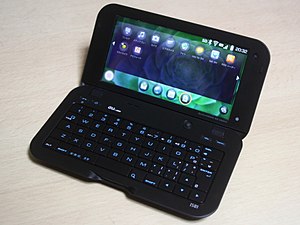
The Sharp IS01 is a smartbook device from Sharp released in 2010. [1]

The Sharp IS01 is a smartbook device from Sharp released in 2010. [1]
It started shipping in June 2010. [2]
It was never released in the United States. [3]
The Sharp IS01 was not well received in a review by Engadget. [1]

BumpTop was a 3D desktop environment that simulates the normal behavior and physical properties of a real-world desk and enhances it with automatic tools to organize its contents. It is aimed at stylus interaction, making it more suitable for tablet computers and handheld PCs. It was created at the University of Toronto as Anand Agarawala's master's thesis. Agarawala also gave a presentation at the TED conference about his idea. The 1.0 version was released on April 8, 2009, along with a fully featured pro version as a paid upgrade. On April 30, 2010 the author announced that BumpTop was being discontinued and that they were taking the software "in an exciting new direction." Two days later, it was announced that the company had been acquired by Google. On January 5, 2011, Google released a sneak preview video of Android 3.0 Honeycomb showing a 3D desktop with features purportedly taken from BumpTop.
This is a list of tablet computers, grouped by intended audience and form factor.

A smartbook was a class of mobile device that combined certain features of both a smartphone and netbook computer, produced between 2009 and 2010. Smartbooks were advertised with features such as always on, all-day battery life, 3G, or Wi-Fi connectivity and GPS in a laptop or tablet-style body with a screen size of 5 to 10 inches and a physical or soft touchscreen keyboard.

Samsung Galaxy is a series of computing and mobile computing devices that are designed, manufactured and marketed by Samsung Electronics. The product line includes the Samsung Galaxy S series of high-end smartphones, the Samsung Galaxy Tab series of tablets, the Samsung Galaxy Note series of tablets and phablets with the added functionality of a stylus, the foldable Samsung Galaxy Z series, and smartwatches including the first version of the Samsung Galaxy Gear, with later versions dropping the Galaxy branding, until the release of the Samsung Galaxy Watch in 2018.

HTC Hero is the third phone manufactured by HTC running the Android platform, announced on June 24, 2009 in London.
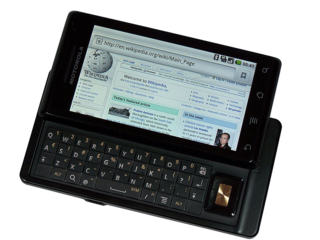
The Motorola Droid is an Internet and multimedia-enabled smartphone designed by Motorola, which runs Google's Android operating system. The Droid had been publicized under the codenames Sholes and Tao and the model number A855. In Latin America and Europe, the model number is A853 (Milestone), and in Mexico, the model number is A854 (Motoroi). Due to the ambiguity with newer phones with similar names, it is also commonly known as the DROID 1. The brand name Droid is a trademark of Lucasfilm licensed to Verizon Wireless.
OPhone, or OMS, is a mobile operating system running on the Linux kernel. It is based on technologies initially developed by Android Inc., a firm later purchased by Google, and work done by the Open Handset Alliance. The OPhone OS has appeared only on China Mobile phones, and the software was developed for China Mobile by software firm Borqs. A modified version of OMS has appeared on other carriers as Android+, also developed and maintained by Borqs. Android has been modified for local Chinese markets by China Mobile's OPhone Software Developers Network.

Lenovo Skylight was a small portable computer with mobile data capabilities designed by Lenovo. The project was announced in January 2010, but was cancelled less than six months later.
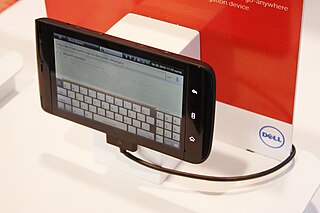
Dell Streak 5 is a smartphone/tablet hybrid ("phablet") from Dell that uses the Android operating system. It comes with a 5-inch (13 cm) capacitive touchscreen and two cameras, a 5MP one with dual-LED flash on the back and a VGA-resolution one on the front for video calling; both are capable of video. The development was first disclosed in June 2009 and in October 2009 it was known that the tablet was capable of making 3G phone calls.

The Xperia Play is a smartphone with elements of a handheld game console produced by Sony Ericsson. With the marketshare for dedicated handheld game consoles diminishing into the 2010s due to the rapid expansion of smartphones with cheap downloadable games, Sony attempted to tackle the issue with two separate devices; a dedicated video game console with elements of a smartphone, called the PlayStation Vita, and a smartphone with elements of a handheld console, the Xperia Play. Originally rumored to be a "PlayStation Phone", the device shed the "PlayStation" branding in favor of the Xperia brand, running on the Android operating system.

The ViewSonic G Tablet is an Android-based tablet produced by ViewSonic Corporation, a manufacturer and provider of visual technology. It first appeared for consumer purchase at Sears on 1 November 2010.
PlayStation Mobile was a software framework used to provide downloadable PlayStation content for devices that meet PlayStation Certified requirements. This includes devices that both run Android 2.3 and met specific hardware requirements, PlayStation Vita, and PlayStation TV. PlayStation Mobile was based on the Mono platform.
The version history of the Android mobile operating system began with the public release of its first beta on November 5, 2007. The first commercial version, Android 1.0, was released on September 23, 2008. The operating system is developed by Google on a yearly cycle since at least 2011. New major releases are announced at Google I/O along with its first public beta to supported Google Pixel devices. The stable version is then released later in the year.

The Asus Eee Pad Transformer TF101 is a 2-in-1 detachable tablet developed by Asus that runs the Android operating system. It is the first tablet in the Asus Transformer Pad series. The Eee Pad Transformer features a 10.1-inch (260 mm) display, an Nvidia Tegra 2 dual-core chip, 1 GB of RAM, and 16 or 32 GB of storage. The tablet initially launched with Android 3.1, nicknamed "Honeycomb", but was updated to support Android 4.0.3.

Google Play, also known as the Google Play Store and formerly Android Market, is a digital distribution service operated and developed by Google. It serves as the official app store for certified devices running on the Android operating system and its derivatives, as well as ChromeOS, allowing users to browse and download applications developed with the Android software development kit (SDK) and published through Google. Google Play has also served as a digital media store, offering games, music, books, movies, and television programs. Content that has been purchased on Google Play Movies & TV and Google Play Books can be accessed on a web browser and through the Android and iOS apps.
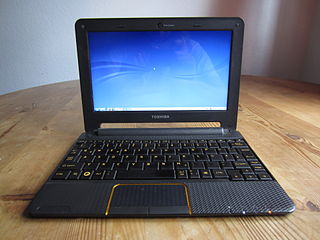
Toshiba AC100 is a smartbook device from Toshiba that was announced in June 2010.
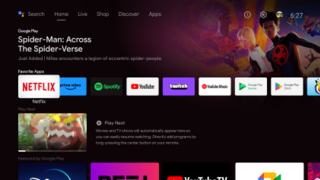
Android TV is a smart TV operating system based on Android and developed by Google for television sets, digital media players, set-top boxes, and soundbars. A successor to Google TV, it features a user interface designed around content discovery and voice search, content aggregation from various media apps and services, and integration with other recent Google technologies such as Assistant, Cast, and Knowledge Graph.

Material Design is a design language developed by Google in 2014. Expanding on the "cards" that debuted in Google Now, Material Design uses more grid-based layouts, responsive animations and transitions, padding, and depth effects such as lighting and shadows. Google announced Material Design on June 25, 2014, at the 2014 Google I/O conference.

Android One is a family of third-party Android smartphones promoted by Google. In comparison to many third-party Android devices, which ship with a manufacturer's customized user interface and bundled apps, these devices run near-stock versions of Android with limited modifications, and a focus on Google services. Devices that run Android One receive OS updates for at least two years after their release, and security patches for at least three years.
Google Podcasts is a podcast application developed by Google and released on June 18, 2018, for Android devices.